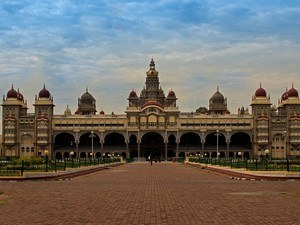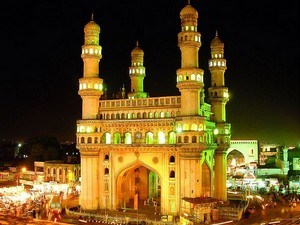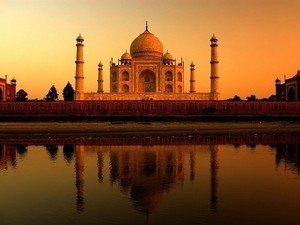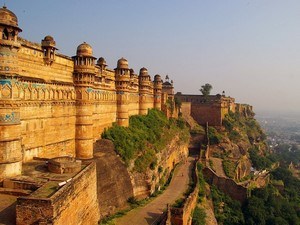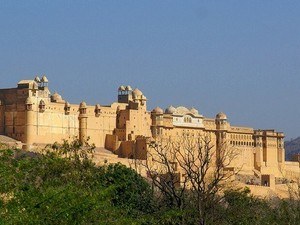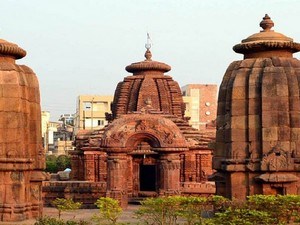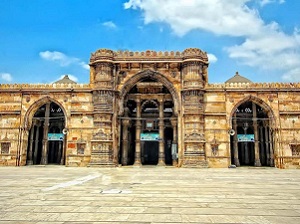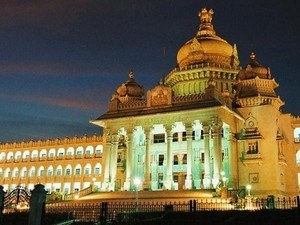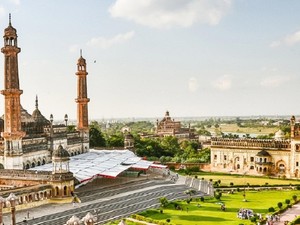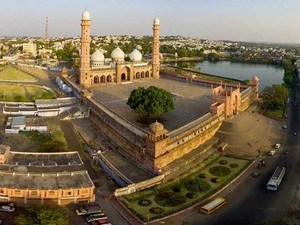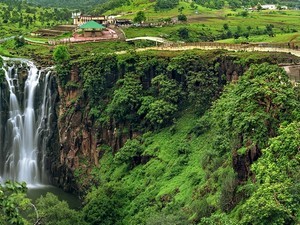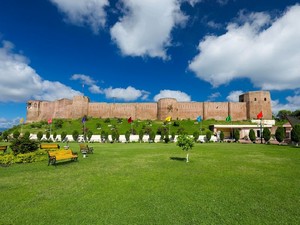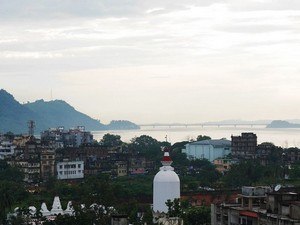1
DAY 1 : TRAVEL TO AGRA & SIGHTSEEING
DAY 1 : TRAVEL TO AGRA & SIGHTSEEING
 Sightseeing
Sightseeing
Leisure / No Sightseeing
At a distance of 6 km from Agra Cantonment Railway Station, Taj Mahal, one of the most popular tourist destinations in the world, is located on the southern bank of the Yamuna River in Agra of Uttar Pradesh State. Taj Mahal was declared as a World Heritage Site by UNESCO in 1983 and it is also counted among the seven wonders of the modern world. It attracts around four million visitors annually. Taj Mahal is the face of Agra Tourism and among the must include place in your Golden Triangle tour packages.
Taj Mahal was commissioned in 1632 by the Mughal emperor Shah Jahan (reigned 1628-1658), in the memory of his favorite wife Mumtaz Mahal. The construction of the monument was completed in 1653. The Taj Mahal was constructed under the supervision of architects Abdul-Karim Ma'mur Khan, Makramat Khan and Ustad Ahmad Lahauri. It took 21 years for the Taj Mahal to be constructed .....
 Duration of visit: 2 Hours
Duration of visit: 2 Hours
 Timings: 6 AM to 6.30 PM. Closed on Friday
Timings: 6 AM to 6.30 PM. Closed on Friday
At a distance of 6 km from Agra Cantonment Railway Station, Taj Museum is one of the most popular museums in Agra and is located in the ground floor of western Naubat Khana, also known as Jal Mahal, with in the Taj Mahal complex.
The museum was established in 1982. It is a double storied building having a quadrangle projection outside and is built on a raised platform. It is a big museum comprising of two floors and has three galleries along with a chief hall. The museum displays various exhibits relating mostly to the construction of the Taj Mahal and to the period of its builders. Totally 121 antiquities are on display, which are broadly categorized as Mughal miniature paintings, manuscripts, government decrees, specimen of calligraphy, arms, utensils, plans and drawings of Taj Complex, paintings, specimen inlay work, marble pillars, etc.
In main hall the paintings of Shah Jahan and his favourite wife Mumtaz Mahal both on ivory, encased in ornamental wooden frame, replicas .....
 Duration of visit: 30 Mins
Duration of visit: 30 Mins
 Timings: 10 AM to 5 PM. Closed on Friday
Timings: 10 AM to 5 PM. Closed on Friday
At a distance of 4.5 km from Agra Cantonment Railway Station and 2.5 Km from Taj Mahal, The Agra Fort, also known as the Lal Qila or Red Fort, is situated on the banks of Yamuna River in Agra, It is among the prime places to visit in Agra City. Uttar Pradesh. The Fort is a UNESCO World Heritage and one of the best forts in India.
Agra Fort was originally a brick fort known as Badalgarh, held by Raja Badal Singh, a Hindu Rajput king (1475 AD). Sikandar Lodi was the first Sultan of Delhi to shift his capital from Delhi to Agra. After Sikandar Lodi died in 1517, his son Ibrahim Lodi held the fort for 9 years until he was defeated and killed in the battle of Panipat in 1526. Several palaces, wells and a mosque were built in the fort during the Lodi period.
After the First Battle of Panipat in 1526, the victorious Babur stayed in the fort, in the palace .....
 Duration of visit: 1 Hour
Duration of visit: 1 Hour
 Timings: 6 AM to 6 PM
Timings: 6 AM to 6 PM
 Overnight Stay in Agra
Overnight Stay in Agra
2
DAY 2 : VISIT FATEPUR SIKRI & TRAVEL TO JAIPUR
%%Itinerary_Title_Day2%%
 Resume Agra Sightseeing
Resume Agra Sightseeing
At a distance of 8 km from Agra Cantonment Railway Station and 3 km from Agra Fort, Tomb of Itimad-ud-Daulah is a Mughal mausoleum located on the western bank of the Yamuna River near the Yamuna Bridge Railway Station in Agra. The tomb is also known as the Jewel Box or Baby Taj as it looks like a smaller version of the Taj Mahal. It is one of the popular Agra tourist places and also one of the top attractions you must include in Agra packages. It is believed that this tomb was the inspiration behind the construction of the Taj Mahal.
Itimad-ud-Daulah is the first monument in India built entirely with marble. The tomb was built between 1622 and 1628 by the Queen of Jahangir, Nur Jahan as a memorial to her father, Mirza Ghiyas. Mirza Ghiyas was an imperial officer and bestowed with the title of Itmad-ud-Daulah (Pillar of State) by Emperor Jahangir.
The .....
 Duration of visit: 30 Mins
Duration of visit: 30 Mins
 Timings: 6 AM to 6 PM
Timings: 6 AM to 6 PM
At a distance of 1 km from Fatehpur Sikri Railway Station, Buland Darwaza or the Gate of Magnificence serves as the main entrance to the Jama Masjid Complex Fort in Fatehpur Sikri of Uttar Pradesh. This massive gate is the highest gateway in the world and it was built in 1576 AD by Akbar to commemorate his victory over Gujarat.
Buland Darwaza is an astounding example of the Mughal architecture. It is made of red and buff sandstone, decorated by white and black marble. One needs to climb a flight of 42 steps in order to reach the gateway, which stands tall at a height of 40 m. The total height of the structure is about 54 m (176 feet) from the ground level. It is a15 storied high gateway acting as the southern entrance of the city of Fatehpur Sikri. It took nearly 12 years to build this magnificent gateway.
It is semi octagonal in plan and two smaller triple storeyed wings on either side. It has three kiosks on its top surrounded by thirteen smaller domed kiosks. There are .....
 Duration of visit: 15 Mins
Duration of visit: 15 Mins
 Timings: 7 AM to 6 PM. Closed on Friday
Timings: 7 AM to 6 PM. Closed on Friday
At a distance of 1 km from Fatehpur Sikri Railway Station, Jama Masjid or Jami Masjid is one of the largest mosques in India and situated on the highest point of the ridge in Fatehpur Sikri Complex. This is one of the most notable tourist attractions to visit in Fatehpur Sikri as part of Agra tour. This mosque was recognized as a World Heritage Site by UNESCO in 1986.
The Jami Masjid was built by Akbar in 1571-72 AD. This is also called Friday mosque. It is the congregational mosque and was perhaps one of the first buildings to be constructed in the complex. It was built under the supervision of Sufi Saint, Sheikh Salim Chishti and his descendants.
The structure of the Jama Masjid is in a rectangular form and is placed on an elevated platform. The mosque has a large courtyard and has gateway entrance from North, South and East. There are series of square shaped chhatris topped by beautiful brackets situated on the other three .....
 Duration of visit: 30 Mins
Duration of visit: 30 Mins
 Timings: 6 AM to 6 PM. Closed on Friday
Timings: 6 AM to 6 PM. Closed on Friday
At a distance of 1 km from Fatehpur Sikri Railway Station, Jodha Bai's Palace (or Jodha Bai Ka Rauza) is one of the largest buildings in the complex of Fatehpur Sikri. This Palace was constructed by Akbar for his favorite wife, Jodha Bai who was a Rajput Princess.
According to history, after Akbar conquered Malwa he faced strong resistances from the Rajput kings. Akbar dealt with the problem diplomatically, allowing them to keep their kingdoms and getting into marriage alliances with the princess of the Rajput clan. He married Jodha Bai, sister of Man Singh, the powerful ruler of Jaipur. She was his favorite queen and allowed to worship Hindu deity in her palace.
Jodha Bai Ka Rauza is an excellent example of the fusion of Hindu and Muslim architectures. The palace has distinct Gujarati and Rajasthani architectural patterns. The palace building consists of a rectangular block with a single magnificent gateway on eastern side, which .....
 Duration of visit: 15 Mins
Duration of visit: 15 Mins
 Timings: 7 AM to 6 PM. Closed on Friday
Timings: 7 AM to 6 PM. Closed on Friday
At a distance of 1 km from Fatehpur Sikri Railway Station, Panch Mahal is five-storey architectural monument located on the northeast direction of Jodha Bai's palace inside the Fatehpur Sikri Fort Complex of Uttar Pradesh.
Panch Mahal was built by Emperor Akbar primarily used as a recreational and pleasure palace by the queens and the other ladies of the court. This is also known as badgir or the wind tower. This pillared pavilion is made of red sand stone comprising of five pavilions, each of which is connected to the next floor by a flight of stairs. The ground floor of the building is made up of 84 pillars that supports the entire structure. As one climbs up the Panch Mahal, the size of the pavilions becomes smaller and the number of pillars supporting the upper floor decreases in number. The first floor has 56 pillars, 20 pillars on second floor, 12 on the third floor and 4 on the fourth level.
The top floor consists of a single dome with floral motifs on top. All the .....
 Duration of visit: 15 Mins
Duration of visit: 15 Mins
 Timings: 7 AM to 6 PM. Closed on Friday
Timings: 7 AM to 6 PM. Closed on Friday
At a distance of 1 km from Fatehpur Sikri Railway Station, Hiran Minar is located close to Caravanserai in Fatehpur Sikri Fort. It is believed that Akbar built Hiran Tower in the memory of his favorite elephant, Hiran. Alternatively, it is also believed that this tower served as a mile post and a light house for the night travelers.
With a height of 21.34 m, Hiran Minar is octagonal at the ground level and circular to the rest of the tower. This is built over an octagonal platform, which in turn stands on a square base. This tower is decorated with an alternate row of hexagons and six point stars. Earlier, elephant tusks were placed emerging from the center of each star, which are now replaced with stone tusks.
The tower is entered through a flat-topped door bordered by sand stone panel and flanked by closed arched panels. There are 53 steps leading to the top inside the tower. One can get a bird's eye view of Fatehpur Sikri from the top of the tower. It is believed that this .....
 Duration of visit: 15 Mins
Duration of visit: 15 Mins
 Timings: 7 AM to 6 PM. Closed on Friday
Timings: 7 AM to 6 PM. Closed on Friday
At a distance of 1.5 km from Fatehpur Sikri Railway Station, Archaeological Museum is situated about 100 m from Diwan-i-Am in Fatehpur Sikri Fort. The structure housing the Archaeological Museum is known as Treasury Building, a centrally protected monument. It was built during Akbar's period. It was in a dilapidated condition and Archaeological Survey of India restored it extensively during 2002-04.
The Museum showcases both pre-Mughal and Mughal artifacts excavated at Fatehpur Sikri. There are four galleries in the Museum. First Gallery displays the objects including micro lithic stone tools of pre-historic period collected during surface exploration from Rasulpur and Patsal near Fatehpur Sikri, Ochre Coloured Pottery, Painted and plain grey ware pot shreds, associated Black and Red ware shreds of Painted Grey Ware culture of early Iron Age, Kushana period from excavation near Hada Mahal and Red ware pottery of different shapes from excavation at Bir Chhabili Tila.
Jain sculptures .....
 Duration of visit: 30 Mins
Duration of visit: 30 Mins
 Timings: 9 AM to 5 PM. Closed on Friday
Timings: 9 AM to 5 PM. Closed on Friday
3
DAY 3 : JAIPUR SIGHTSEEING
%%Itinerary_Title_Day2%%
At a distance of 13 km from Jaipur Junction Railway Station, Amer Fort or Amber Fort is located in Amer near Jaipur. It is one of the best-preserved forts in Rajasthan, and among the prime place to include in Jaipur packages.
Amber was founded by the Meenas in 967 AD and they dedicated the town to Amba, the Mother Goddess. Around 1037 AD, Amber was conquered by Kachhawa Rajputs and ruled from the 11th to the 18th century, until the capital was moved from Amer to Jaipur. The Amber Fort was built by Raja Man Singh in 1592 AD and it was further expanded by successive rulers. Man Singh was one of the trusted generals of Emperor Akbar and one among the Navaratnas of his court. Later in 1727 AD, Sawai Jai Singh II moved the capital from Amber to Jaipur.
The architecture of Amer Fort is influenced by both Hindu and Muslim styles. Among the famous tourist places in Jaipur, Amer .....
 Duration of visit: 2 Hours
Duration of visit: 2 Hours
 Timings: Timings: 8 AM to 5.30 PM
Timings: Timings: 8 AM to 5.30 PM
At a distance of 11 km from Jaipur Junction Railway Station and 8 km from Amer Fort, Jal Mahal or the Water Palace is a palace located in the middle of the Man Sagar Lake in Jaipur. This is one of the biggest artificial lakes in Jaipur. The lake used to be a bird watcher's paradise in the past and was a favorite ground for the Rajput kings of Jaipur for royal duck shooting parties during picnics.
Jal Mahal was built in 18th century by Sawai Madho Singh I. Jal Mahal was constructed for serving the purpose of a summer resort for his family and guests. The palace was renovated and expanded in the 18th century by Madho Singh II. The Jal Mahal palace is considered an architectural beauty built in the Rajput and Mughal styles of architecture. It provides a picturesque view of the lake from the Man Sagar Dam and the surrounding Nahargarh hills. The palace was built using red sandstone. It is a five storied building out of which four floors remain under water when the lake is full and the .....
 Duration of visit: 30 Mins - 1 Hr
Duration of visit: 30 Mins - 1 Hr
 Timings: 9 AM to 5 PM
Timings: 9 AM to 5 PM
At a distance of 11 km from Jaipur Junction Railway Station, Khole Ke Hanuman Ji is an ancient temple situated at Laxman Dungri in Jaipur. This temple is considered to be one of the famous temples in Jaipur, and among the must include places in Jaipur tour packages.
Khole Ke Hanuman ji Temple is dedicated to the Lord Hanuman. The inner sanctum of the temple is quite large and can accommodate 500 devotees. The temple is situated on a hillock and devotees have to walk around 1 km to reach the temple. The temple has an attractive entrance archway. The temple is known for its magical power and it is believed that the wishes of the devotees are always fulfilled. It is one of the popular Jaipur places to visit, especially for religious people.
The natural view of Aravali hill is magnificent from the temple and surrounding places. A large number of tourists .....
 Duration of visit: 1 Hour
Duration of visit: 1 Hour
 Timings: 6 AM to 8.30 PM
Timings: 6 AM to 8.30 PM
At a distance of 6 km from Jaipur Junction Railway Station, Birla Mandir is a Hindu temple located at the base of Moti Dongri Hill in Jaipur. The temple is sometimes also referred to as the Laxmi Narayan Temple. It is one of the major places to visit in Jaipur.
This marvelous temple was built during the year 1988 by Birla Group of Industries, one of the business tycoons of India. According to history, the Birla temple was built on the land given to the Birla family by the Maharaja.
The Temple is dedicated to Lord Vishnu (Narayan) and his consort Lakshmi. The images of Lakshmi and Narayan attract the attention, being made out from one piece of marble. Standing on a raised platform, Birla Temple is made out with the premium quality of white marble. The temple looks stunning, when it is brightly lit in the night. The three huge domes of the temple represent three different approaches to the religion. .....
 Duration of visit: 1 Hour
Duration of visit: 1 Hour
 Timings: 6 AM - 12 PM & 3 PM - 8:30 PM
Timings: 6 AM - 12 PM & 3 PM - 8:30 PM
4
DAY 4 : JAIPUR SIGHTSEEING & TRAVEL TO DELHI
%%Itinerary_Title_Day2%%
At a distance of 5.5 km from Jaipur Junction Railway Station, City Palace is a beautiful palace complex situated in the heart of Jaipur City. It is one of the popular palaces in Rajasthan, and among the famous places to visit as part of Jaipur tour.
The palace was built between 1729 and 1732 AD by Sawai Jai Singh II. He planned and built the outer walls and later additions were made by successive rulers till the end of the 20th century. City Palace was the seat of the Maharaja of Jaipur, the head of the Kachhwa Rajput clan. Part of the palace currently houses a museum, though the major part is still a royal residence. It one of the most famous Jaipur tourist places.
The City Palace reflects Rajput, Mughal, and European architectural styles although it was designed according to Vaastushastra. The Palace .....
 Duration of visit: 1-2 Hours
Duration of visit: 1-2 Hours
 Timings: 9 AM to 5 PM
Timings: 9 AM to 5 PM
At a distance of 5.5 km from Jaipur Junction Railway Station, Jantar Mantar is located near City Palace and Hawa Mahal in Jaipur. It is one of the top tourist places in Jaipur City. This monument is the largest of the five astronomical observatories present in India. The other four astronomical observatories are located at Delhi, Varanasi, Mathura and Ujjain. It features the world's largest stone sundial, and is a UNESCO World Heritage site.
The Jantar Mantar was built by the Rajput king Sawai Jai Singh II and completed in 1738 AD. The name is derived from jantar means yantra and mantar means calculation. The Jaipur observatory was functional for seven years only, as the Maharaja was not very successful in deriving accurate, astronomical observations. It was later restored in the year 1901 and was declared as a national monument in the year 1948.
The .....
 Duration of visit: 30 Mins - 1 Hr
Duration of visit: 30 Mins - 1 Hr
 Timings: 9:30 AM to 4:30 PM
Timings: 9:30 AM to 4:30 PM
At a distance of 6 km from Jaipur Junction Railway Station, Hawa Mahal is one of the prime tourist places to visit in Jaipur city. The palace sits on the edge of the City Palace and extends to the Zenana (women's) chambers. Hawa Mahal is often represented in promotion of Jaipur Tourism. Jaipur is among the top places to visit near Delhi.
The renowned Hawa Mahal or the Palace of Winds was constructed in 1799 by Maharaja Sawai Pratap Singh as a continuation to the stunning City Palace. The main architect of this palace is Lal Chand Ustad and the palace is believed to have been constructed in the form of the crown of Krishna, the Hindu God.
Hawa Mahal was built in Rajputana architectural style. The palace is constructed of beautiful red and pink sandstone and it looks like a five storeyed Pyramid. The palace stands on a podium which is fifty .....
 Duration of visit: 30 Mins
Duration of visit: 30 Mins
 Timings: 9 AM to 4.30 PM
Timings: 9 AM to 4.30 PM
At a distance of 6 km from Jaipur Junction Railway Station, Albert Hall Museum is a museum situated in Ram Niwas Garden outside the city wall opposite the new gate in Jaipur. It is the oldest museum in Rajasthan, and one of the popular places of sightseeing in Jaipur.
The Albert Hall Museum is functioning as the State Museum of Rajasthan. The Hall was built by Maharaja Sawai Ram Singh II. The foundation stone of Albert Hall was laid during the visit of the Prince of Wales, Albert Edward to Jaipur in 1876 and it was completed in 1887. The building was designed by Sir Samuel Swinton Jacob and was opened as a public museum in 1887. It is also called the Government Central Museum. Maharaja Ram Singh initially wanted this building to be a town hall, but his successor, Madho Singh II, decided it should be a museum for the art of Jaipur.
It is a fine example of Indo-European architecture. The design of .....
 Duration of visit: 1-2 Hours
Duration of visit: 1-2 Hours
 Timings: 9 AM to 5 PM on all days. Closed on Friday
Timings: 9 AM to 5 PM on all days. Closed on Friday

